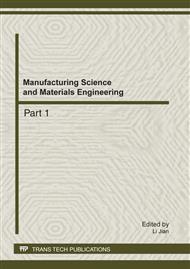[1]
T. Izumi, Y. Ibuki, M. Yamashita, H. SHIMIZU, S. Nakayama and H. Abe, High-efficient linear oscillatory actuator drive systems optimized current waveform, Power Conversion Conference - Nagoya, pp.925-930, (2007).
DOI: 10.1109/pccon.2007.373077
Google Scholar
[2]
S. B. Yoon, I. S. Jung, K. C. Kim and D. S. Hyun, Dynamic analysis of a reciprocating linear actuator for gas compression using finite element method, IEEE Transactions on Magnetics, vol. 33, no. 5, pp.4113-4115, (1997).
DOI: 10.1109/20.619680
Google Scholar
[3]
A. Yoshitake, K. Haraa, T. Tcdaka, Y. Ishihara and K. Hirata, Dynamic analysis of a linear oscillatory actuator under feedback control, IEEE Transactions on Magnetics, vol. 33, no. 2, pp.1662-1665, (1997).
DOI: 10.1109/20.582590
Google Scholar
[4]
D. K. Kim, D. Y. Lee, C. G. Jung, and G. T. Kim, Improvement of operating characteristics for mc-loa taking account ofpermanent magnet arrangement, IEEE Transactions on Magnetics, vol. 40, no. 4, pp.2038-2040, (2004).
DOI: 10.1109/tmag.2004.832506
Google Scholar
[5]
T. H. Kim, H. W. Lee, Y. H. Kim, J. Lee, Development of a flux concentration-type linear oscillatory actuator, IEEE Transactions on Magnetics, vol. 40, no. 4, pp.2092-2094, (2004).
DOI: 10.1109/tmag.2004.832461
Google Scholar
[6]
R. E. Clark, D. S. Smith, P. H. Mellor, D. Howe, Design optimisation of moving-magnet actuators for reciprocating electro-mechanical systems, IEEE Transactions on Magnetics, vol. 31, no. 6, pp.3746-3748, (1995).
DOI: 10.1109/20.489758
Google Scholar
[7]
H. Enomoto, K. Harada, Y. Ishihara, T. Todaka, Optimal design of linear oscillatory actuator using genetic algorithm, IEEE Transactions on Magnetics, vol. 34, no. 5, pp.3515-3518, (1998).
DOI: 10.1109/20.717829
Google Scholar
[8]
N. Nishizawa, T. Ishii and H. Yamada, Performance analysis of a linear oscillatoryactuator for a milking unit, IEEE Transactions on Magnetics, vol. 9, no. 6, pp.122-126, (1994).
DOI: 10.1109/tjmj.1994.4565968
Google Scholar
[9]
Y. Takano, S. Yaezaki, K. Matsumoto, N. Nishizawa and H. Yamada, Thrust simulation of a linear oscillatory actuator, IEEE Transactions on Magnetics, vol. 33, no. 2, pp.2085-2088, (1995).
DOI: 10.1109/20.582729
Google Scholar
[10]
N. Misron, W. K. Chai, M. Norman, Thrust characteristics of linearoscillatory actuator for liquid pump and its effect to vibration, The Fifth International Symposium on Linear Drivesfor Industry Applications, pp.60-63, (2005).
Google Scholar
[11]
Yunyue Ye, Principle and Application of Linear Motor, BeiJing: China Machine Press, 2000 (In Chinese).
Google Scholar
[12]
Jianhua Wu, Design and Application of Switched Reluctance Motor, BeiJing: China Machine Press, 2000 (In Chinese).
Google Scholar
[13]
Wugang Tian, Mengchun Pan, Lixiang Chen, Linear Synchronous Motor magnetic field and Force FE Simulation Analysis, Micromotors, Vol. 37, pp.19-21, April 2004 (In Chinese).
Google Scholar
[14]
R. E. Clark, G. W. Jewell and D. Howe, Finite element analysis of short-stroke linear motors and actuators, Current Trends in the Use of Finite Elements in Electromechanical Design and Analysis(Ref. No. 2000/013), IEE Seminar on, 8/1-8/6.
DOI: 10.1049/ic:20000055
Google Scholar


